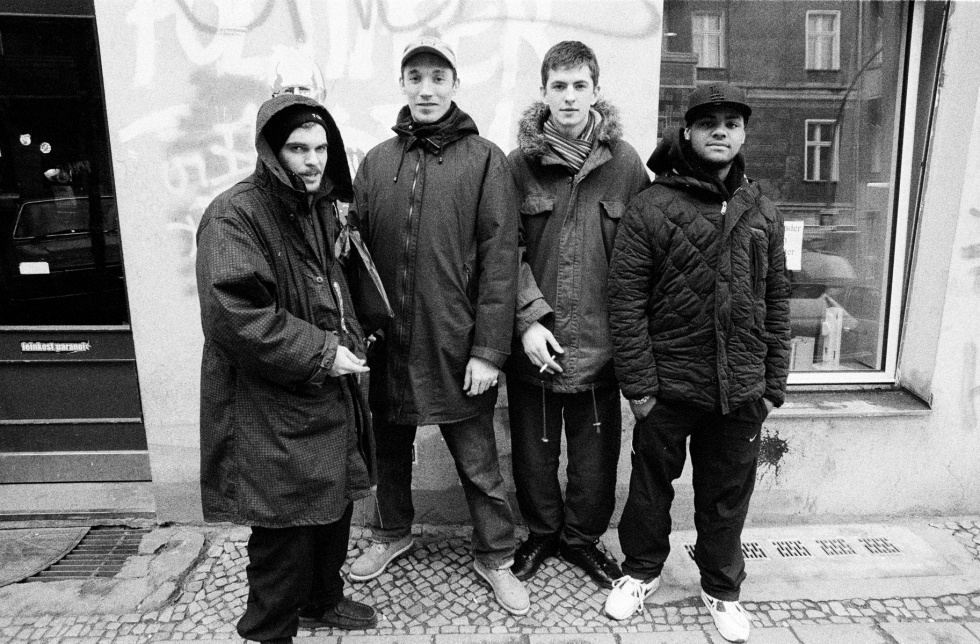
DJ Maxximus, Hi Jak, Skream & Point (Berlin, 2006); Photo: © Orson Sieverding
2006 was a pivotal period for dubstep in the UK and abroad. It was the year of DMZ’s first anniversary, an event so over-subscribed it had to change venues half way through. Ten years on — and ahead of tonight’s dubstep appreciation session with Hatcha, Bukez Finezt, Orson and Saiman — this is the story of dubstep in Berlin, primarily from 2006 – 2008: the key players, trends, clubs, sounds and substances.
2006: GRIME TIME
Before dubstep took centre-stage in Berlin’s nightlife circuit, there was an avid crew of local promoters and club owners, all collectively obsessing over what was happening in the London scene. Around the turn of the century, Berlin had a thriving drum and bass community with a broad policy in regards to international bookings.
In 2002, Tricky D – a local drum and bass/breakbeat producer behind the Tricky Tunes record store in Freidrichshian – booked Kode9 for his first Berlin performance. “Tricky D was way ahead of everyone else,” recalls Sasha Perera. The London-born, Berlin-based DJ/producer (Jahcoozi, Sasha Elsewhere) was one of the key members behind the Grime Time events series in 2004. The regular party series, which initially took place at the WMF Sommerlager, would become a springboard for the city’s dubstep scene, and a meeting place for like-minded figureheads.
Perera refers to the one day it all kicked off, while talking to WMF club owner Gerriet Schulz (who also part of the city’s drum and bass community), “In 2004, this guy Christian Fussenegger came in with a whole load of burned CDs with all this music on it from London,” she tells me. The music – Wiley’s debut LP and a Nasty Crew mix – had been acquired while Fussenegger had been working as a video-journalist, creating a documentary about London’s grime scene.
“I told Gerriet we had to do something about this.” And in the summer of that year Grime Time was born, with the first event playing host to Kano, D Double E and JME.
“As an event series, [Grime Time] was responsible for bringing together various actors within one of the city’s most prestigious dubstep promotions team, Freak Camp.”
As an event series, it was responsible for bringing together various actors within one of the city’s most prestigious dubstep promotions team, Freak Camp. It was also the catalyst for Revolution no.5, a grime-based events series run by Alexandra Droener and Johanna Grabsch (better known as the Sick Girls).
It also spearheaded the Berlin FWD>> parties, established by Orson Sieverding – who would go on to be associated with the Version label and events – and Frederic Stader, aka DJ Maxximus.
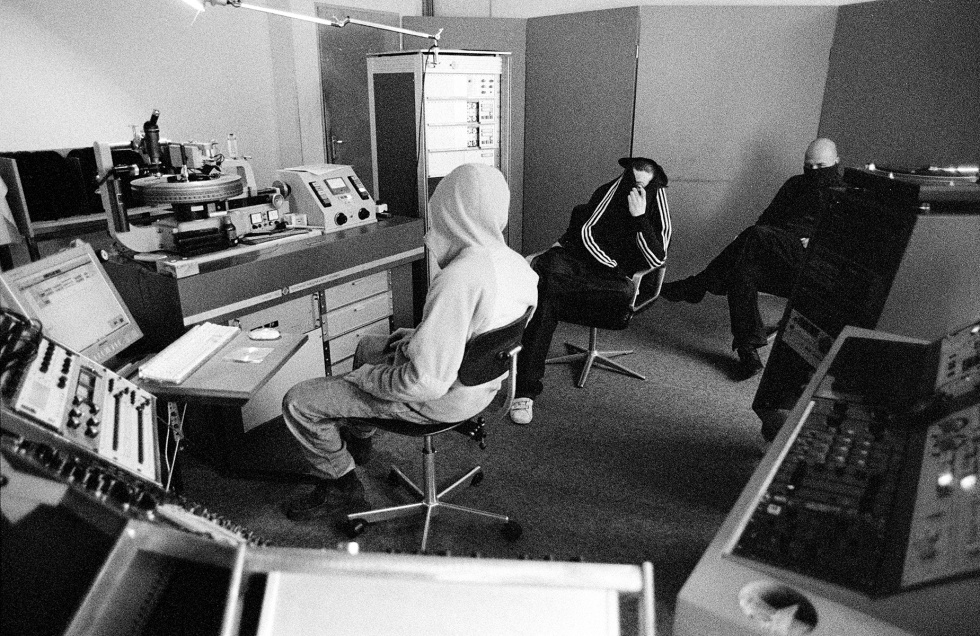
Maxximus, Point, Skream, Hi Jak & Mackjiggah at Dubplates & Mastering Cutting House (Berlin, 2006); Photo: © Orson Sieverding
2006: FREAK CAMP, BASS THE WORLD, FWD>>
“Moving back to Berlin in 2005 I wanted a start in journalism and to get involved with music,” explains Daniel Fersch (aka Danny Bwoy). Fersch would go on to become a leading authority in the city’s dubstep scene through his work with GROOVE-Magazin, Germany’s foremost electronic music magazine. In 2007, Fersch started the magazine’s Mehr Bass! [More Bass] column – a summary of all things dubstep and more – and went on to produce some of Germany’s first articles about the dmz events.
It was at one of the first Grime Time parties in 2005 (at Dresden Bahnhof with Skepta, JME, Tinchy Stryder and Plastician) that he met Simon ‘Audiomassive’ (aka. Z-Mon), who was behind one of the scene’s most important events forum, Keepitrollin.
“They were trying to get a crew together and put on a monthly night that was going to be better than FWD. They seemed to be a bit crazy, but likeable.”
“They were trying to get a crew together and put on a monthly night that was going to be better than FWD. They seemed to be a bit crazy, but likeable.” Fersch was subsequently invited to play the dubstep and grime room at Kir Royal, Keepitrollin’s New Year’s Eve ender. It was here that Fersch met with Thomas 2krazy and J-Trex –the forefathers of the Freak Camp community.
“They were trying to get a crew together and put on a monthly night that was going to be better than FWD,” Fersch explains, smiling quirkily at the thought. “They seemed to be a bit crazy, but likeable.” 2krazy’s iconic design work, and the crew’s booking policy, brought the Freak Camp crew recognition throughout Berlin.
At its height, Freak Camp consisted of eight different acts, all fulfilling different roles within the get-up. Their first party took place on March 2006 in an old bank vault, called THCell on Potsdamerstraße; but due to licensing restrictions they weren’t allowed to promote it. “The first official Freak Camp party was with Pinch in June. We also had Jamie (vex’d) play at a spontaneously organised session in July, as well as N-Type, but in the end THCell closed because of complaints from neighbours.”
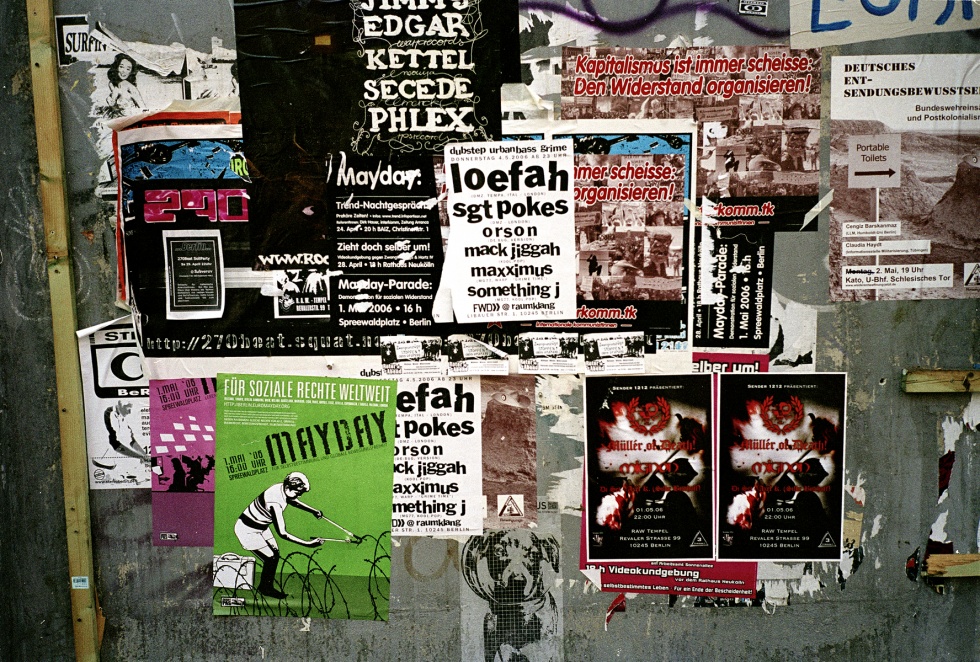
FWD Berlin Posters (Berlin, May 2006); Photo: Orson Sieverding
Across town, Maxximus and Orson had launched Berlin’s FWD>> nights at Raumklang. Orson had been a regular contributor for Germany’s other leading electronic music publication De:bug, and had also spent a lot of time in London video-documenting the growing grime and dubstep scene.
“We ended up doing three nights,” he explains. “First with Skream, then Kode9 and then with Loefah”. Maxximus, originally from the digital hardcore and hip-hop scene, scored a 2001 garage hit “Mercedes Bentley vs Versace Armani” released on Warp Records alongside Something J.
The first event took place on March 6th and saw them team up with 679 Records. It was officially titled, Run The Road vs. FWD>>, after the 679’s grime compilation of the same name.
The team went their separate ways after the three events, with Maxximus starting the Bass The World dubstep nights at Maria. Orson moved to Dusseldorf and set up Version nights at the legendary Salon des Amateurs, before taking the nights to Cologne and Wuppertal. Eventually he returned to Berlin in 2009, where he ran the Version nights at Horst Krzbrg with DJ Hops from Hardwax. Since 2015, he’s also been running the Swamp81 nights at Ohm Club.
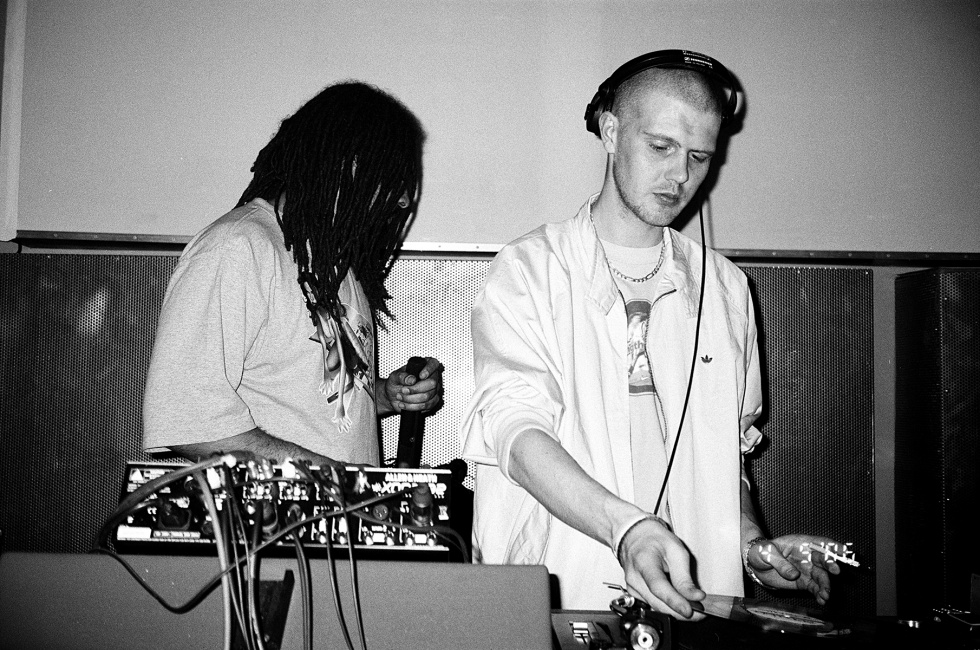
Sgt Pokes & Loefah at FWD Berlin (Berlin, May 2006); Photo: Stephan Machac
2007: THE EX-PAT CONTINGENT/HARD WAX
Skull Disco’s Appleblim and Shackleton came over to Berlin in early 2007 for a show at Trompete, a jazz club in the Schoenberg district. “I interviewed them for Groove,” Fersch says, about the incident. “I think it was their first Berlin show. I met them in HARDWAX, and talked to them with Torsten (Pröfrock – one of the store’s main figureheads).”
Sasha Perera also happened to be at that show. “I can tell you what: there were two girls there, and I was one of them”. Shackleton eventually moved to Berlin in 2008 and found himself in good company, alongside other expats Jamie Vex’d, Cosmin TRG, 2562 (A Made Up Sound) and Scuba. You could also include Emika, Geiom, George FitzGerald and Machinedrum in that pack.
“It was this melding of UK sounds and established Berlin underground electronic music that saw dubstep’s evolution. And at the very heart of this was Hard Wax, one of the city’s prestigious record stores.”
“Berlin was a place where you could do something different,” says Paul Rose about his move in the summer of 2007. With dubstep blowing up in London, Rose took to the German capital to express his creativity and distance himself from a side of the scene that wasn’t representative of his style. It was this melding of UK sounds and established Berlin underground electronic music that saw dubstep’s evolution. And at the very heart of this was Hard Wax, one of the city’s prestigious record stores.
“People like DJ Pete and Torsten at Hardwax were very interested in what we were doing, and very supportive,” Rose explains. Torsten Pröfrock was not only chiefly responsible for bringing dubstep to Hard Wax’s shelves, but also an amazing producer who lauded many prestigious admirers.
His Din label, productions with Monolake, and as T++, were disrupters, changing the way many interpreted electronic music. “T++ hinted at what I wanted to be doing with dubstep,” Rose recounts.
Hardwax’s back office is connected through an adjoining door with Dubplates and Mastering, where DJ Maxximus was cutting records back in 2006. “When I was working there, I was listening to all the tunes on Dubplates.net,” Maxximus details. “One day Torsten, who was sitting on the other side and listening came on over. Week by week I showed him what was going on,” Maxximus goes on to explain. “And that was when Hard Wax started digging [dubstep].”
THE BERLIN SOUND
“Berlin doesn’t strike me as a scene where there’s that much looking outside, it’s quite insular,” Rose says, about the Berlin assimilation of dubstep culture. Interestingly between 2006 and 2008, the amount of Germans actually making dubstep were few and far between. “I think that’s a reflection of the Berlin scene; that Berlin is more likely to listen to the periphery of something rather than take from something that’s big elsewhere.”
Local artists Maxximus and Mackjiggah were making beats that lived on the grimier side of things. There was also Wadadda and Phokus with their more traditional sounding dubstep, while Modeselektor were blending together elements with German hip hop, dub and bass on the 2007 LP, Happy Birthday!
It was techno’s acknowledgement of the growing dubstep community that started the biggest shift in the sound’s contextual paradigm. “That dubstep-techno crossover thing was very short lived, but it produced some very interesting music while it lasted,” Rose explains. “It was very much Berlin; a melding of this 90s techno sound, minimal from 2000, and dubstep – squashed together, with some very cool sounding results.”
It was records such as 2562’s “Channel Two”, T++’s “Voice No Bodies”, Pangaea “Router”; records by Martyn, Appleblim and F that embodied this brief movement. “Hard Wax has been pushing the London stuff from very early on. The crossover potential was immediately obvious as the London dark garage music was very dub influenced and Hard Wax is the dub techno shop. Hard Wax has an exalted position in the Berlin scene, and that for them to be pushing stuff must have an influence.”
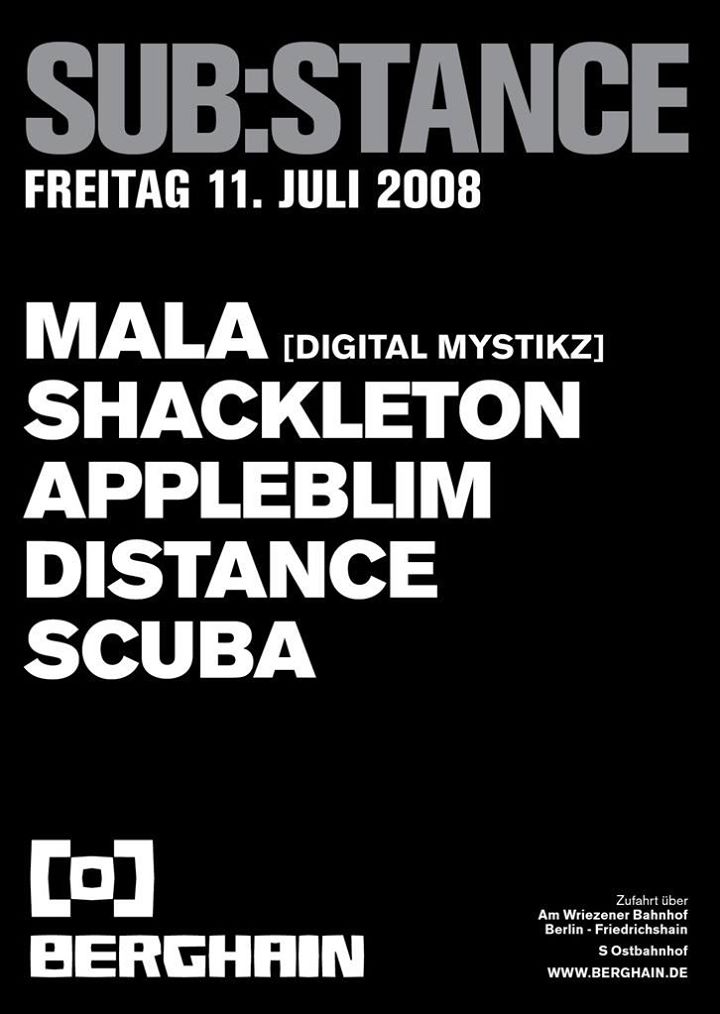
2008: THE YEAR OF SUBSTANCE
“There’s a big jump from selling records to people throwing big parties. It takes something more; the stars have to align. But they did and in 2008 you had 1500 people wanting to go to a dubstep night in Berlin.” In July of that year, Paul Rose teamed up with his then booking agent Paul Fowler, to start Sub:Stance at Berghain. It was the first time the club had put on a regular series of events on a Friday night. It was a showcase where dubstep kids could listen to techno, and techno kids could listen to dubstep.
The first billing featured Mala alongside Appleblim, Shackleton, Scuba, Distance and T++. The event ran for five years, and epitomised the evolution of dubstep outside of London. During its course, Sub:Stance played host to a multitude of styles including house, jungle and classic UK dubstep, along with a hubris of sounds that remain unclassifiable.
Along the way it hosted DJ Pete, 2562, Kode9, The Bug, Headhunter, Loefah, dBridge, Dillinja, Rusko, Wookie, Pinch, Pearson Sound, Deadbeat, Kahn and more. It immediately transformed the landscape in Berlin.
“What we were pushing was not what was big in the UK. [It was] stuff like Skull Disco, and labels like Tectonic and our label. There was interest in it, but the big things were DMZ, Skream and Benga, for example. We were sort of peripheral to that. The music made much more sense to Berghain.”
“As Sub:Stance went on, the more it distanced itself from its traditional dubstep roots. The evolution was indicative of what was happening globally, and within the Berlin dubstep community as a whole.”
As Sub:Stance went on, the more it distanced itself from its traditional dubstep roots. The evolution was indicative of what was happening globally, and within the Berlin dubstep community as a whole. Superstars were being created, and the discrete, poly-rhythmic sound that defined London, became more defined by a bass-heavy, distorted movement.
It was around this time that Daniel Fersch decided to leave the Freak Camp team. “It really had felt like a movement for those two years,” he laments. “Back then, people didn’t ask for huge fees, and then the whole wobble thing took over.”

Orson & Loefah at FWD Berlin (Berlin, May 2006); Photo: Stephan Machac
Sub:Stance stopped running in 2013, almost ten years after the first Grime Time event. Paul Rose, after arriving in Berlin as a dubstep DJ, left as a techno artist. To this very day it’s still possible to hear a DJ playing a set replete with tracks that defined that time. But now the music that once seemed like a progressive, pioneering movement now only serves to reminisce. Orson, now celebrating 10 years of his Version events, likens it to a Metalheadz moment; a point in time when the music was as exciting and forward thinking as Goldie’s pioneering standard.
A shout-out to the other dubstep crews that need mentioning – Standards, Dubmarine, Shadowland, Schlomo, Version, Bassfieber and Siruius. Also to the stores, Tricky Tunes, Hard Wax, Dense (RIP) and the clubs, Icon (RIP), Subland, Gretchen, WMF (RIP), Cassiopeia, THCell & Kapital (RIP), VCF (RIP), Maria and anyone we missed out.
We presented a double header project of dubstep-only sessions earlier this month. Ready yourselves for music from London and Berlin: Hatcha, Bukez Finezt, Orson, Saiman. Also, dive into our Spotify playlist reminiscing about some of our favourite sounds from that period.